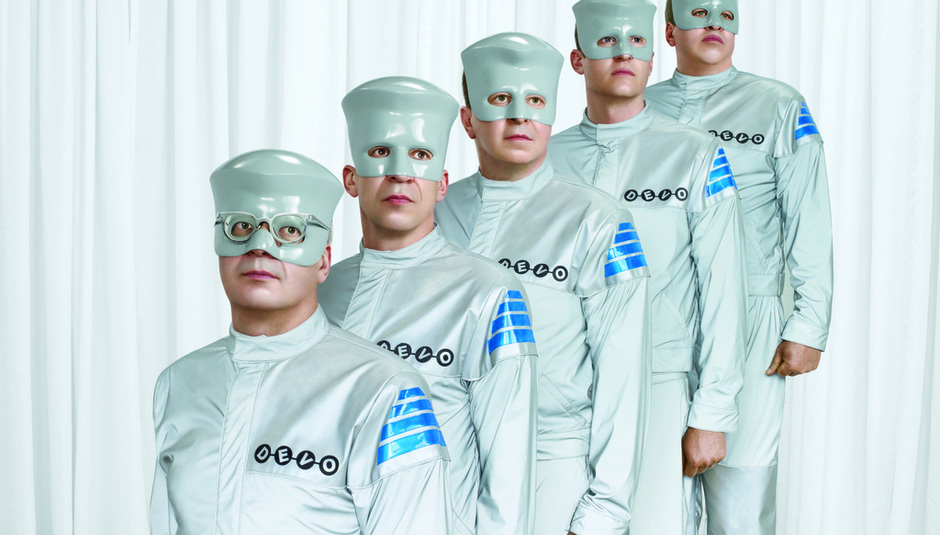Mark Mothersbaugh is showing me his impression of Sid Vicious. He’s standing next to a coffee table, scanning the room and sliding the lid of a coffee pot towards the edge with his fingertips. It teeters for a moment, then falls. He explains: “When The Sex Pistols played their last show in San Francisco, Devo had played a punk club the night before. We slept in the offices of a magazine called ‘Search and Destroy’ and after The Sex Pistols show they came over there to party with us. Sid was with Nancy. There’d be a bottle of beer on a table, and he’d be going like this. Looking around. Then he’d push it a little closer. Keep looking around. Then he’d push it over: CRASH! Then he’d look around and realise nobody gave a shit, so then he went and did it again somewhere else. He did it three or four times and then he realised he wasn’t gonna get anybody upset, so he quit.”
Devo were never a band who smashed things. Mothersbaugh liked Vicious, liked that he was true to what he stood for, but Devo eschewed nihilism. They were playing club shows in 1978 surrounded by punk upstarts, but they had long since decided that rebellion didn’t lead anywhere. They had witnessed the starkest imaginable demonstration. On 4th May 1970, founding members Mothersbaugh, Gerald Casale and Bob Lewis were students at Kent State University when the Ohio National Guard shot dead four unarmed students at a protest against the invasion of Cambodia.
Devo’s art still ripples with the impact of that seismic day: “The thing that we took away from that is that rebellion is obsolete. We came to the opinion that rebellion and nihilism weren’t really the way to affect change in our culture. We came to the conclusion that the best way to affect change was through subversion. Who really affects culture? It seemed like it was Madison Avenue.”
So on Something for Everybody, their first new album in twenty years, Devo tell us that they’ve taken the dark arts of the advertising industry and applied them to their music. ‘88% Focus Group Approved’ declares the sticker on the CD case, after the band asked fans to vote for the track listing on their website. Their iconic red Energy Domes are now blue, another decision by focus group. It’s worryingly reminiscent of the ‘Most Wanted’ artwork by the graphic artists Komar and Melamid who took a focus group approach to creating art and found that what people want is banal blue landscapes.
Fortunately, the music on Something for Everybody is anything but banal. Somehow, despite the intervening years, Devo still sound ahead of their time. Meanwhile all this stuff about focus groups is just part of Devo’s Dadaist satire, isn’t it? “Yeah, and maybe no”, says Motherbaugh. For a start, they really did work with the advertising agency Mother LA: “We talked Warner Brothers into hiring an ad agency for us. Three years ago, if you’d have said ‘In 2010 you’re going to put out a record on Warner Brothers Records’, I’d have said ‘You, my friend, are hallucinating. There is no possible way I would do that. There is not one compelling reason.’ Somehow, in the last year I went and met them and it was interesting to hear them say: ‘We know we’re going to be obsolete in five years, we know that record companies as they exist now are useless and needless, but we’re going to put one last effort behind seeing if we can redefine what a record company is.’ I thought that sounded intriguing.”
He finds it quaintly amusing that Warner Brothers still insist on releasing “unnecessary” CDs: “I mean, okay, it’s a little souvenir, but most people are still going to get the music from the internet.” Mothersbaugh has even less time for that last resort of the desperate label, the re-release ‘with bonus material!’: “The record companies already got you for a third time! After you bought the records, they’ve got you to buy the cassette of your favourite album, and then they got you to buy the CD of your favourite album. Then because they could, they threw in other crap that wasn’t part of the original presentation. That’s like saying ‘Well, when I painted that painting that’s what I originally did, but now that I can I’m going to add some other crap on the side that wasn’t there originally.’ All of a sudden the original intention has been perverted for the sake of a record company trying to make an extra couple of bucks trying to sell one more version of a record.”
Mothersbaugh seems to be enjoying watching the death throes of the record industry, but then he’s been predicting it for years. He knew that labels were out of touch with the MTV generation when he had to convince them it was worthwhile spending money on music videos, but their self preservation instinct soon kicked in. “I thought that ‘sound and vision’ was going to be the death of rock’n’roll. I thought I’d never have to listen to another Rod Stewart album, because by the time the Eighties get here it’s going to be visual artists who also make music, or musicians who also do visual art, and it will eliminate all those dinosaurs that were out there. I was wrong. What really happened was record companies took a look at what bands like Devo were doing in making these films and they said ‘We need to do that for Van Halen!’ They became moronic within like five minutes. The whole concept became subverted and was assimilated by the status quo of the rock machine, and it allowed the music industry, as it had existed for thirty or forty years, to hang in there for another ten or fifteen years.”
The internet is changing all that, and Devo have embraced it in a way that it’s difficult to imagine many of their contemporaries doing. When Mothersbaugh talks about the internet it is with the fervour of a true believer: “The internet has already so radically changed the way artists create art, the way artists present art, the way people view art, the way people perceive art. I think YouTube is a much more successful version of what ‘sound and vision’ should be than MTV. It’s not about budgets. It’s not about Michael Jackson paying $175,000 to do ‘Thriller’, or Madonna spending $190,000 to do her last video, or Lady Gaga doing the most incredible spectacle ever. I’m not saying that any of those were necessarily bad videos. I mean, those were great. ‘Thriller’ was great. Lady Gaga is really talented and does really good work. I’m just saying that the field has been leveled because of YouTube and access to technology. Artists have been empowered. All the record companies are wringing their hands and going ‘No-one is buying our beautiful records any more!’ I say ‘Hoody-hoo-hoo! You made that work for a really long time, and either we applaud you for your cunningness or shame on you for keeping people captive for so long and being able to dictate what we were allowed to listen to and to watch’. Now, you go to YouTube and the most important thing is a good idea: something that’s great and somebody who is talented at delivering it.”
Devo were making homemade videos to showcase their great ideas long before YouTube came along. They filmed ‘The Truth About De-Evolution’, a music video for their tracks ‘Secret Agent Man’ and ‘Jocko Homo’ in 1974, four years before they released their debut album. The success of that video led to Neil Young inviting them to appear in his experimental film ‘Human Highway’. Having initially dismissed it, Mothersbaugh is pleased by how “weird” the film remains on repeated viewings. “Neil Young crushed my playpen! Half of the score is him fooling around with synths. He’s an interesting guy! He was really interested in The Sex Pistols. His half of the score sounds like Gary Numan to me. My half sounds like Pee-wee Herman.”
It is his work as a soundtrack composer, for the likes of ‘Pee-wee Herman’, ‘Rugrats’ and last year’s ‘Cloudy with a Chance of Meatballs’ that has kept Mothersbaugh occupied in the years since Devo’s last record. Film scores are not just a way to pay the rent, however. His scores for Wes Anderson, in particular ‘Rushmore’, ‘The Royal Tenenbaums’ and ‘The Life Aquatic with Steve Zissou’ have been brilliant, at turns playful, touching and just plain hilarious. Mothersbaugh says there are plans to work with Anderson again, once he’s overcome his transatlantic separation from the anglophile director. Once again, he evangelises the ability of the internet to provide the solution: “Now there’s technology where we can be on screen talking, but we can also put the movie in the top corner of the screen and both touch it. He can make marks on the film and I can take music and try it out. It’s like being in the same building but we’re just on each side of a plate of glass!”
Mothersbaugh’s obvious delight at the opportunities new technology presents his art, and his constant striving to break new ground, arguably sits somewhat uneasily alongside Devo’s decision to play a ‘Don’t Look Back’ performance of their debut album Q: Are We Not Men? A: We Are Devo! last year. Mothersbaugh agrees that it was a “contra-intuitive” decision, but one that proved to be “a learning experience”. He says that the concept behind the shows didn’t make sense to him until they did it: “Onstage, playing it that night, I said ‘What a brilliant idea’, because I realised that I could think of at least two dozen albums that I would love to hear the artists play Song 1, Side 1 all the way through to the end of Side 2, because that’s the way I experienced that music when I first experienced it, and that became the imprint of my memories and my best experiences. If I could hear the Ziggy Stardust album from Song 1 all the way to the song on Side 2, I’d die and go to heaven. There’s at least a half dozen Stones or Beatles albums I’d feel the same way about.”
They resisted the initial desire, however, to take a similarly atavistic approach to the new album: “When we first started I had this kinda romantic notion, ‘Hey! Let’s get the same gear we used for album one and let’s go in a room and get a four track recorder and let’s do it the same way we did the first album. Everybody was not so sure about that, but we tried it for about a month and I was the only one pushing it. Then I started thinking about why the other guys weren’t into it and why did it not seem right, and I realised we did nine albums and they weren’t like that. We didn’t go back to the first album every time. By the time we had our fourth album, Lynn drum machines had come out. We got a Fairlight by the time our sixth album came out. We were always embracing technology, so it was kinda ingenuous to decide that we’re going to artificially pretend that we’re 22 again.”
So what has changed since they were 22? “If you see a Devo live show you’ll be like, ‘Oh, they all learned how to play their instruments over the last thirty years!’ You can’t be what you were, but I think it’s a logical progression.” When Mothersbaugh talks about Devo, he doesn’t seem to talking about it as a band. He seems more like he’s talking about a hilarious art experiment that he can’t quite believe he’s still getting away with. “I don’t think all of us would call ourselves musicians, really. We were influenced by the artists of the time when we were starting the band. It was Andy Warhol who I really paid attention to because he was a painter, and he was a photographer, and he was a silkscreen artist, and he was a fashion designer and all these different things. What I took from it was that technology was plastic and that it was available for an artist to use whatever fit his needs. There was no restriction to just music or sound. You could be a visual artist and an audio artist at the same time. You didn’t have to be in one category. We thought with Devo we were going to be Akron, Ohio’s version of Andy Warhol’s Factory. I remember early on thinking that Devo wasn’t even going to be us as band members. I thought we were going to hire people as our little agitprop groups and they could go out and be Devo. We thought we could have like five Devos out at once, if we were that successful!”
A version of this was almost realised with Devo 2.0, a “kinda flawed” collaboration with Disney which saw children covering Devo songs. Wait! A collaboration with Disney? Aren’t these the same guys who sued McDonalds for using their hats on a Happy Meal toy? Mothersbaugh can’t help but laugh. “It was definitely a subversive way to infiltrate the minds of young kids that maybe someday would find out about Devo 1.0 and be curious.” In fact, Devo have never been too worried about letting their art be used by corporations. ‘Whip It’ alone has appeared in advertisements for Twix, Pringles, Jeep, Taco Bell and Swiffer dusters. Mothersbaugh jokes: “I could do a reel of them all, and by the end of it you’d say ‘This is the band De-Ho’”. I get the impression he sees each one as a victory, an infiltration of the mainstream by Devo’s own brand of weirdness and something his hero would have firmly approved of: “I met Andy Warhol a few times and I think if he were alive he’d love where we were taking things. It’s blurring the lines between pop and fine art, and fine art and commercial art.”
Devo never smashed things because they never needed to: they do rebellion their own way. Their prophecy of de-evolution may have been proved right by a lowbrow media intent on cultural homogeneity, but simultaneously the rise of the internet has created a new space for artists like Devo to thrive in, a base from which to launch their assaults on the establishment. “If I was a kid now I think it would be a great time to be starting off as an artist. I think there are so many possibilities if you want to be an artist who creates visual or sound art,” Mothersbaugh concludes. “I feel like we may be more in our time than we were back in the Seventies.”
Devo’s new album ‘Something For Everybody’ was released by Warner Bros. Records on Monday June 14th. Further info: www.clubdevo.com























